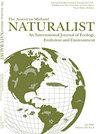卡罗莱纳州和弗吉尼亚州皮埃蒙特高地草本植物区系的耐荫性分类
IF 0.6
4区 环境科学与生态学
Q4 Agricultural and Biological Sciences
引用次数: 4
摘要
摘要历史记载描述了美国东南部皮埃蒙特部分地区的草原状条件,至少可以追溯到1500年代。这些开放的栖息地被认为是由于人类的发展、灭火和当地放牧动物的消失而减少的。不幸的是,我们目前对社区组装和维护动态的初步了解阻碍了恢复和维持皮埃蒙特大草原的保护工作。将物种有力地分类为与树冠开放性相关的专业和多面手协会,将有助于理解这一点,而目前这种分类在大范围内是不可用的。因此,我们的目标是根据该地区的定量地块数据,为卡罗莱纳州和弗吉尼亚州的山地皮埃蒙特草本植物区系制定耐荫分类。为了实现这一目标,我们使用了来自卡罗莱纳州植被调查的地块记录数据集(代表天然和半天然植被)。这些是1977年至2015年间调查的公共和私人土地上的永久地块。经过质量控制,数据集包含1300个地块和1550个物种(包括去除单一出现后的835个本地草本物种),地块中的物种丰度按覆盖类别报告。我们根据其树种的覆盖代码估计了每个地块的树冠覆盖率,并将每个地块划分为栖息地遮荫等级:开放(75%的树冠覆盖;n=1097)。我们计算了点双序列相关系数(rpb),该系数为每个物种提供了正值或负值,这取决于其丰度和栖息地关联。在我们的分析中,我们考虑了单一(开放、半开放或封闭)和组合(开放+半开放、封闭+半开放或开放+封闭)栖息地类别。在数据集中的835种本地草本物种中,我们发现141种(17%)是日生植物(树冠覆盖率为75%的开放栖息地的专家),尽管数据集中84%的地块被归类为封闭栖息地。我们的工作表明,开放和半开放的栖息地可能包含不成比例的区域草本植物区系多样性,并为800多种草本物种提供了第一个定量的耐荫分类。这项工作提供了一种资源,可供野外生物学家和土地管理者用于确定日光植物群落,并评估栖息地恢复和创造工作的成功。本文章由计算机程序翻译,如有差异,请以英文原文为准。
Shade-Tolerance Classification of the Upland Herbaceous Flora of the Carolina and Virginia Piedmont
Abstract. Historical accounts describe savanna-like conditions over portions of the Piedmont of the southeastern United States dating at least as far back as the 1500s. These open habitats are thought to have declined because of human development, fire suppression, and loss of native grazing animals. Unfortunately, conservation efforts to restore and sustain Piedmont savanna are hampered by our current rudimentary understanding of community assembly and maintenance dynamics. Such understanding would be facilitated by a robust classification of species into specialist and generalist guilds related to canopy openness, a classification that is currently unavailable on a broad scale. Consequently, our objective was to develop a shade-tolerance classification for the upland Piedmont herbaceous flora of the Carolinas and Virginia, based on quantitative plot data from the region. To achieve this objective, we utilized a dataset of plot records (representing natural and semi-natural vegetation) from the Carolina Vegetation Survey. These are permanent plots on public and private land that were surveyed between 1977 and 2015. Following quality control, the dataset contained 1300 plots and 1550 species (including 835 native herbaceous species after single occurrences were removed), with species abundances in plots reported in cover classes. We estimated the canopy cover of each plot from the cover codes of its tree species and assigned each plot to habitat shade classes: open (<25% canopy cover; n = 63), semi-open (25–75% canopy cover; n=140), or closed (>75% canopy cover; n=1097). We calculated point biserial correlation coefficients (rpb), which provided a positive or negative value for each species, dependent on its abundance and habitat association. We considered single (open, semi-open, or closed) and combined (open+semi-open, closed+semi-open, or open+closed) habitat classes during our analysis. Of the 835 native herbaceous species in the dataset, we found 141 (17%) to be heliophytes (specialists of open habitats with canopy cover <25%), and only 81 (10%) to be sciophytes (specialists of closed habitats with canopy cover >75%), despite 84% of plots in the dataset being classified as closed habitats. Our work suggests that open and semi-open habitats may contain a disproportionate diversity of regional herbaceous flora and provides the first quantitative shade-tolerance classification for over 800 herbaceous species. This work provides a resource that can be used by field biologists and land managers to identify heliophyte communities, and to assess the success of habitat restoration and creation efforts.
求助全文
通过发布文献求助,成功后即可免费获取论文全文。
去求助
来源期刊

American Midland Naturalist
环境科学-生态学
CiteScore
1.20
自引率
0.00%
发文量
38
审稿时长
18-36 weeks
期刊介绍:
The American Midland Naturalist has been published for 90 years by the University of Notre Dame. The connotations of Midland and Naturalist have broadened and its geographic coverage now includes North America with occasional articles from other continents. The old image of naturalist has changed and the journal publishes what Charles Elton aptly termed "scientific natural history" including field and experimental biology. Its significance and breadth of coverage are evident in that the American Midland Naturalist is among the most frequently cited journals in publications on ecology, mammalogy, herpetology, ornithology, ichthyology, parasitology, aquatic and invertebrate biology and other biological disciplines.
 求助内容:
求助内容: 应助结果提醒方式:
应助结果提醒方式:


